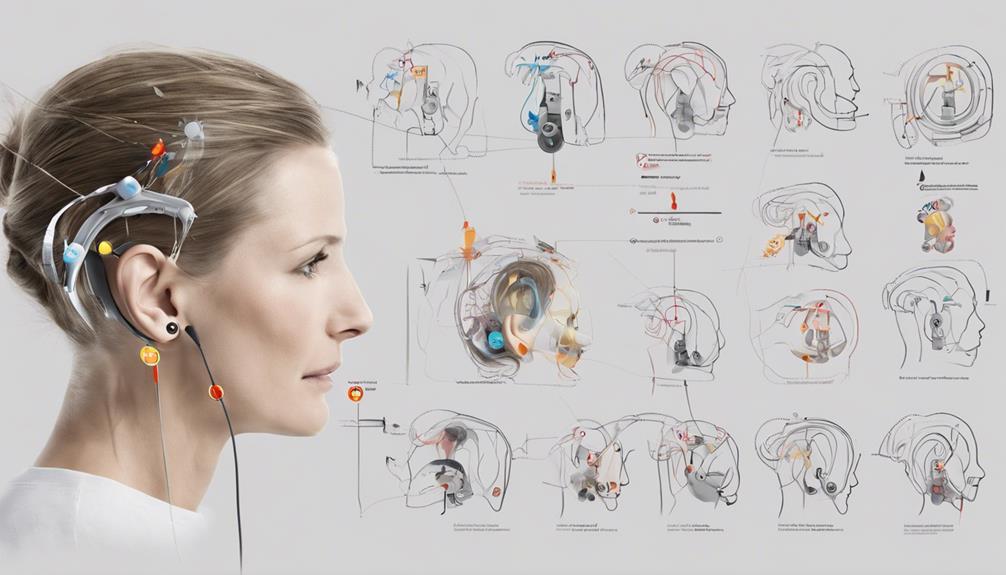In achieving successful outcomes with cochlear implants, understanding the nuances of auditory training is like adjusting a finely crafted musical instrument.
As we explore the depths of maximizing success rates with cochlear implants, we uncover key strategies and insights that play a pivotal role in the journey to improved hearing outcomes.
The quest for optimal results in cochlear implantation beckons us to unravel the complexities of post-implantation care and rehabilitation, where a world of possibilities awaits those seeking to enhance their auditory experiences.
Key Takeaways
- Tailored auditory rehabilitation techniques optimize outcomes for cochlear implant recipients.
- Gradual progression from simple to complex tasks enhances adaptation and sound perception.
- Regular maintenance and monitoring ensure long-term success and implant functionality.
- Collaborative evaluations and individualized care plans maximize cochlear implant success rates.
Pre-Implantation Assessments
During pre-implantation assessments, we conduct thorough evaluations to determine candidacy for cochlear implants. These assessments are crucial in determining the potential benefits of cochlear implantation for individuals with severe hearing loss. Speech perception tests, word recognition scores, and hearing aid trials are utilized to assess the auditory performance of potential cochlear implant recipients. By analyzing these factors, we can better understand how well a person can comprehend speech and sounds, providing valuable insights into the effectiveness of a cochlear implant.
Psychological evaluations are also integral as they help in evaluating the patient's readiness, expectations, and emotional preparedness for the implantation process.
Imaging studies, such as CT scans or MRIs, play a vital role in evaluating the cochlear anatomy to determine the feasibility of surgical implantation. These tests are essential for assessing the structure of the cochlea, ensuring the proper placement of the cochlear implant. Through a collaborative effort involving audiologists, otolaryngologists, speech-language pathologists, and psychologists, we ensure a comprehensive evaluation process that optimizes patient selection for cochlear implants.
Surgical Procedure and Recovery

Upon completion of the pre-implantation assessments, the next crucial step in the cochlear implant process is the surgical procedure and subsequent recovery phase.
The surgical procedure, typically lasting 2-4 hours under general anesthesia, involves the implantation of the device. Following surgery, patients may need to stay in the hospital for 1-2 days for monitoring and initial activation of the cochlear implant.
Post-operative care is essential, focusing on keeping the incision site dry and clean to prevent infection. It's common for individuals to experience temporary dizziness or balance issues after surgery, which usually subside within a few days.
Rehabilitation and activation of the cochlear implant device are usually scheduled 2-4 weeks post-surgery to ensure proper healing. This phase marks the beginning of the journey towards improved hearing ability, and proper care during the recovery period plays a vital role in maximizing the success of the cochlear implantation process.
Auditory Rehabilitation Techniques
Implementing tailored auditory rehabilitation techniques plays a pivotal role in optimizing the auditory outcomes for cochlear implant (CI) recipients by enhancing their speech recognition abilities and overall auditory plasticity. Active auditory training is essential for maximizing auditory plasticity, particularly considering factors like the duration of deafness.
Targeted auditory training significantly enhances speech recognition in CI patients, highlighting the need for additional auditory rehabilitation efforts. Different auditory training protocols may be required for varying listening conditions, with explicit training and meaningful feedback crucial for challenging listening situations.
Research is focused on developing efficient training protocols to minimize costs associated with auditory rehabilitation while maximizing the benefits of cochlear implants. Progressing from simple to complex stimuli and using varied and relatively difficult stimuli can enhance the recognition of both easy and challenging sounds for CI patients.
It's evident that the strategic implementation of auditory training programs, tailored to individual needs, is key to improving speech perception and overall auditory outcomes post cochlear implantation.
Optimizing Sound Perception

To optimize sound perception in cochlear implant users, tailored auditory training protocols are essential for enhancing speech recognition abilities and promoting auditory plasticity. By implementing specific auditory training techniques, such as varied training stimuli and electrode strategies, individuals with cochlear implants can experience improved stimulation and adaptation to different listening conditions. These training protocols are designed to target sound perception directly, helping users better navigate complex auditory tasks and ultimately enhance their overall auditory experience.
Research has shown that engaging in auditory training with challenging stimuli can lead to significant advancements in recognizing both simple and complex sounds. Furthermore, the process of starting with simpler auditory tasks and gradually progressing to more intricate ones allows for enhanced auditory plasticity over time. By incorporating diverse training stimuli and strategies, cochlear implant users can maximize their ability to adapt to various listening conditions, ultimately optimizing their sound perception capabilities.
Long-Term Care and Maintenance
Our focus now shifts to the essential aspects of long-term care and maintenance required for ensuring the optimal performance and longevity of cochlear implants. Regular maintenance plays a critical role in upholding the effectiveness of cochlear implants. Here are some key points to consider:
- Maintenance: Regular cleaning of external components and monitoring battery life are crucial tasks.
- Care Guidelines: Adhering to recommended care guidelines, such as avoiding moisture and extreme temperatures, can prevent damage.
- Follow-Up Appointments: Routine visits to audiologists or specialists are vital for monitoring implant function and addressing concerns promptly.
- Signs of Malfunction: Being aware of signs like changes in sound quality or sudden hearing loss can prompt timely professional assistance for troubleshooting.
- Handling Techniques: Educating oneself and caregivers on proper handling and troubleshooting techniques contributes significantly to the longevity and effectiveness of cochlear implants.
Frequently Asked Questions
Do Cochlear Implants Have a 100% Success Rate?
No, cochlear implants don't have a 100% success rate. While outcomes vary, factors like age at implantation and auditory training can influence success. Most users see improved speech perception and quality of life.
Success rates are generally high, with enhanced communication abilities and better social interactions reported. While not everyone achieves perfect hearing, the majority benefit from improved sound perception and speech understanding.
What Factors Influence the Success of Cochlear Implants?
When looking at the factors influencing the success of cochlear implants, we consider variables such as duration of deafness, speech performance, and the impact of active auditory training. Understanding these elements is key to optimizing implant outcomes.
Targeted auditory training is shown to significantly enhance speech recognition in implant recipients. Ongoing research strives to develop more effective training protocols for maximizing the benefits of cochlear implants.
Different training methods and materials also play a crucial role in determining success rates.
What Age Group Does Better With Cochlear Implants Why?
We find that younger age groups, particularly children implanted before the age of 3, tend to exhibit better outcomes with cochlear implants.
This is attributed to the concept of neuroplasticity and the benefits of early auditory stimulation.
Early implantation in infants and toddlers allows for optimal development of auditory skills, language acquisition, and speech perception, ultimately leading to accelerated progress in spoken language development and communication skills.
Why Are Cochlear Implants Sometimes Not Successful?
Sometimes cochlear implants are unsuccessful due to factors like:
- Poor electrode placement
- Limited nerve function
- Inadequate auditory processing abilities
Lack of rehabilitation, delayed implantation post deafness, and individual variations in age and motivation can also impact outcomes.
Other reasons for unsuccessful cochlear implants may include:
- Surgery complications
- Device malfunctions
- Improper programming
Addressing medical conditions, optimizing settings, and providing support can help improve success rates.
Conclusion
In conclusion, maximizing success with cochlear implants requires dedication to auditory training and ongoing care.
Just as a gardener tends to their plants with patience and precision, we must nurture our hearing abilities with diligence and commitment.
By embracing the journey of auditory rehabilitation, we can cultivate a thriving garden of sound perception and communication skills, blossoming with the fruits of improved speech recognition and quality of life.
Let's continue to nurture our auditory health for a flourishing future ahead.











